Inov-8 Roclite Pro G 400 Gore-Tex ($235)

Introduction
Sam: The inov-8 Roclite Pro G 400 is an ultra light (14 oz / 400g) boot with the trail feel of a rugged trail runner and the support, stability and grip of a stout hiking boot. It is designed for moving fast in the mountains.

Bridging the worlds of trail running, fast hiking/ fast packing, and trekking,, the G 400 is loaded with a Schoeller ceramic coated upper, Gore-Tex XCR bootie, plenty of firmer cushion, rear stability from its External Heel Cage and agile protection up front from its flexible Meta-Plate Pro and is of course shod with inov-8's Graphene Grip outsole
inov-8 is from the north of the UK where the trails are rough, wet and wild, if they exist at all, and this is, as all their shoes are is a boot with that territory’s DNA. 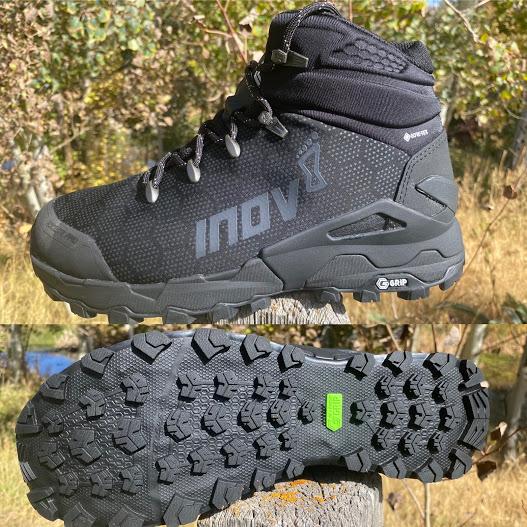
Pros:
Sam:
Very light, supportive boot with the front flex and agility of a trail runner
Generous toe box fit
Impeccable all terrain grip
Durable and protective: by specs and material high level of abrasion (Schoeller ceramic coated upper) and water resistance (Gore-Tex).
Highly versatile for moving fast over any terrain.

Jana:
Very light, all terrain shoe, waterproof
Toe box is wide, yet does not have a floppy feel to it, and the front part of the shoe is very flexible and grippy when climbing very steep terrain.
Heel feels secure and comfortably sitting, and the collar is stout but comfortable as well.
No problem with laces getting loose, or undone from the hooks.
Outsole is very grippy, even in muddy/wet terrain.
Cons:
Sam:
Clearly premium priced.
Where does it fit in your line up? between trail runner and hiker for most
Could use a bit more and a bit more forgiving cushion stack as found in trail run G 270
Actually a bit roomy and almost loose upfront in my half size up on my narrower foot likely due to no overlays
Jana:
A bit pricey
Mud can get stuck/build up between lugs a little due to close lugs positioning.
Breathability is limited, a tradeoff given the Gore-Tex membrane.
Tester Profiles
Jana Herzgova took up running in 2016 after a back injury. Prior to that she was a speed skater, but due to back pain and doctor's recommendation, she transitioned into running. Since then, starting with shorter ultra distance races she quickly evolved into an avid long distance and unsupported mountain runner. She also loves to take on challenges/races in arctic and subarctic climates, mainly in unsupported and semi-self supported style. She runs about 100 miles per week: 40 miles on road and 60 miles trail mostly at high elevations. She currently lives in Utah/Wyoming.
Sam is the Editor and Founder of Road Trail Run. He is 63 with a 2018 3:40 Boston qualifier. Sam has been running for over 45 years and has a 2:28 marathon PR. These days he runs halves in the just sub 1:40 range training 30-40 miles per week mostly at moderate paces on the roads and trails of New Hampshire and Utah. He is 5'10" tall and weighs about 163 lbs.
Stats
Official Weight:: men's 14oz / 403g (US9) / women's / (US8)
Samples: 14.2 oz / 403g US M9
11.5 oz / 325g US W11
Midsole Stack Height: 20mm / 12mm, 8mm drop
6mm lugs
Available now. $235
First Impressions and Fit
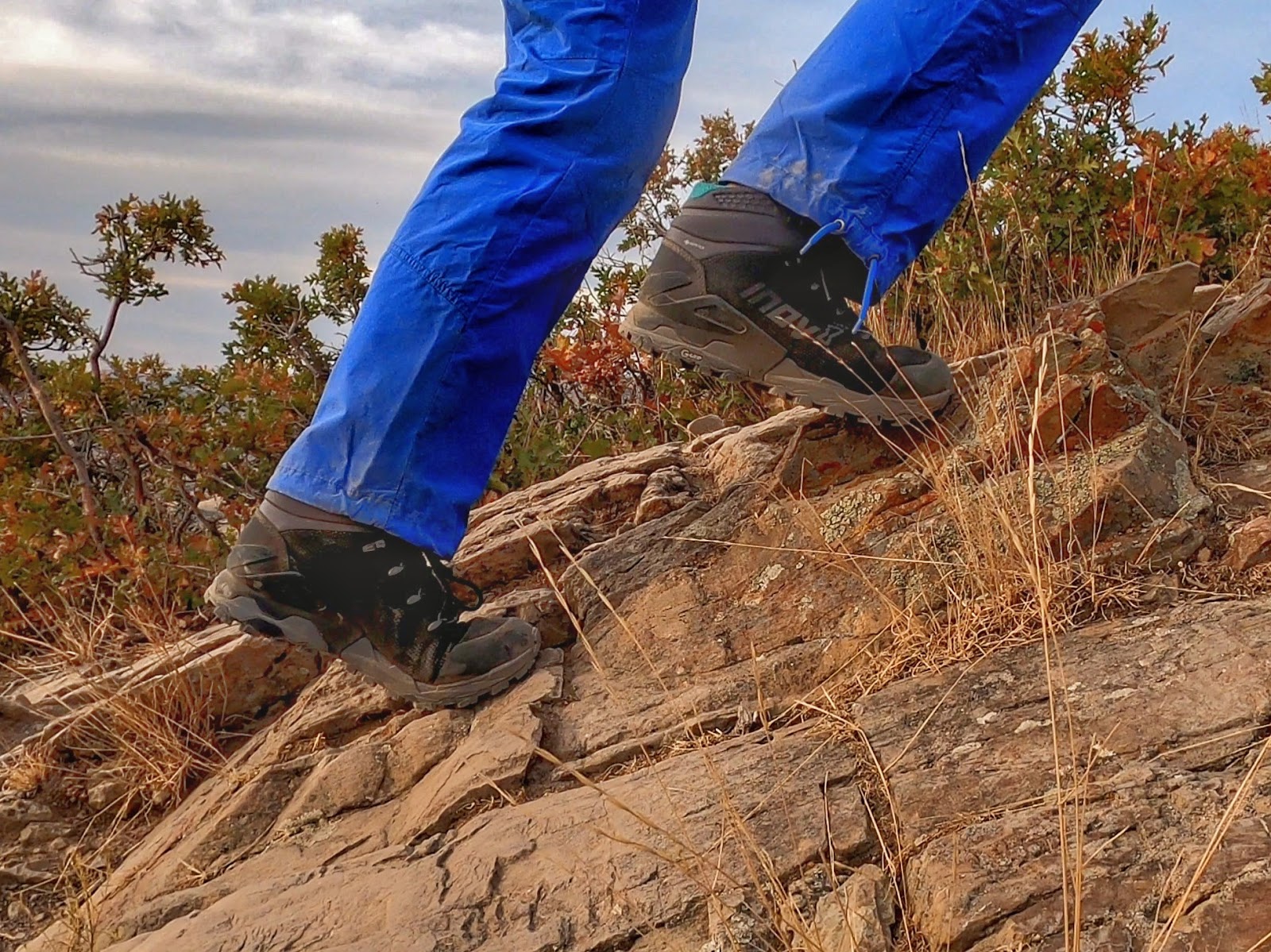
Jana: It has been about 3 years since I wore hiking shoes for the last time, and I did not have a good experience with them (Columbia brand, don't remember the model). As a mainly trail runner, I was initially skeptical to use and review hiking shoes due to my previous experience.
I must say I was very pleasantly surprised when I put them on. I wore them for a whole day around my house at first, without wearing socks, and they were comfortable and light. No experience with chafing at all. I did about 70 miles of fast hiking on rugged mountain terrain in them. The boot over all is well cushioned, yet light, with plenty of room in the toe box. Stable feel and grippy outsole made for a secure and comfortable fast moving ride across the very rugged mountain terrain I cover.
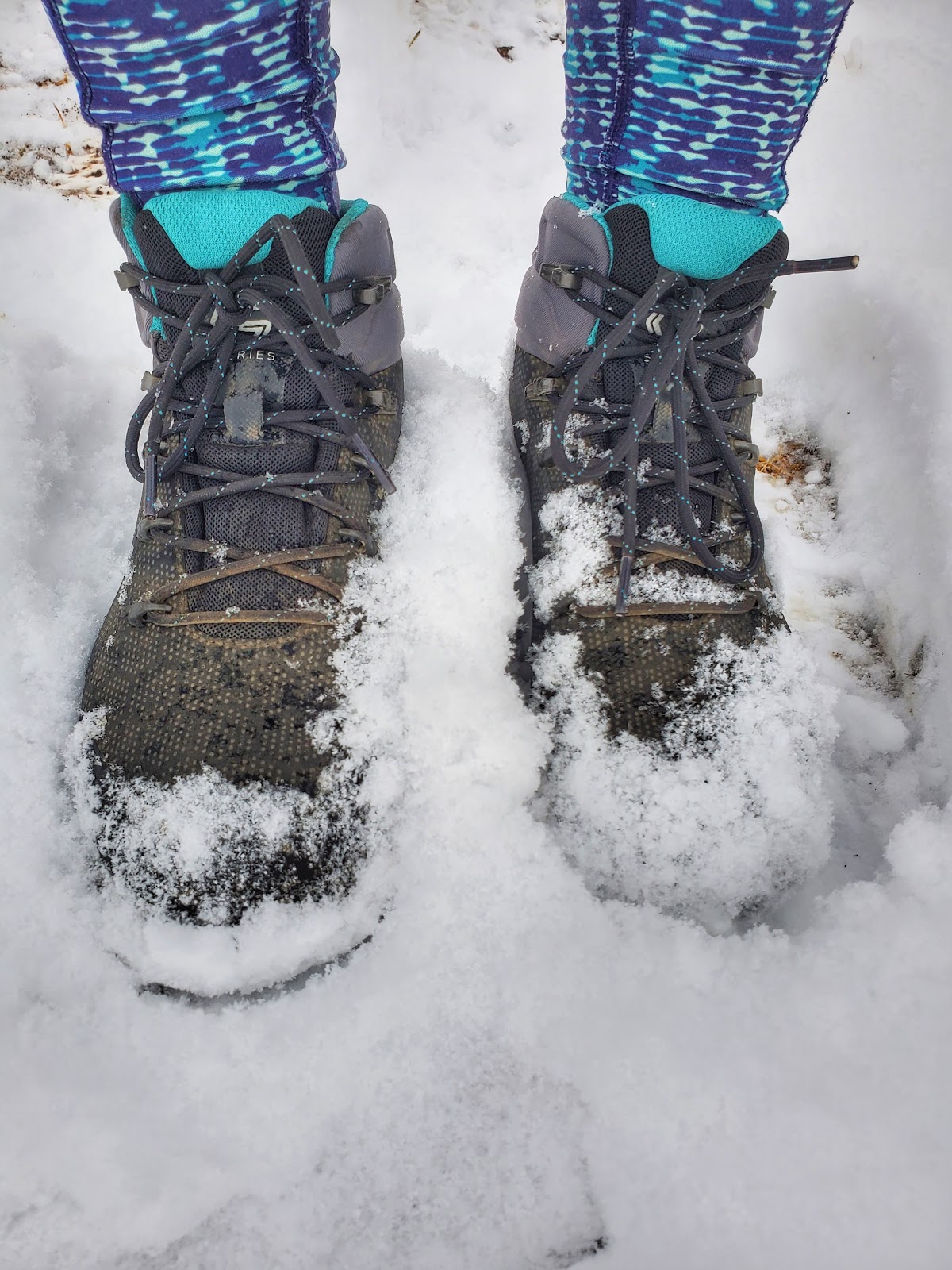
Sam: If you are familiar with Inov-8 glove light performance fits the G 400 has clearly a roomier fit. I was sized up half a size and could have gone true to size but chose half size up to plan for winter socks.The rear collar aided by the Meta-Plate Pro is at the same time flexible and very supportive.

While the boot looks stout and serious, and it is all in black, it is also surprisingly light in hand and on the foot. Due to Meta-Plate Pro which extends from rear and side support walls as the External Heel Cage to the front as rock protection it is both more flexible than the typical boot and as flexible as most trail runners yet also torsionally very rigid and stable. This combination says to me that it will climb extremely well while handling downhills at speed just as ably which it did in testing!
Upper

Jana: I purposely tried to scratch/rip the Schoeller ceramic-coated fabric upper on rocky/rugged terrain, without success. The Gore-Tex waterproof lining feels comfortable and durable.

Plastic caging around the heel and rubber toe layer add extra protection, yet does not feel bulky.
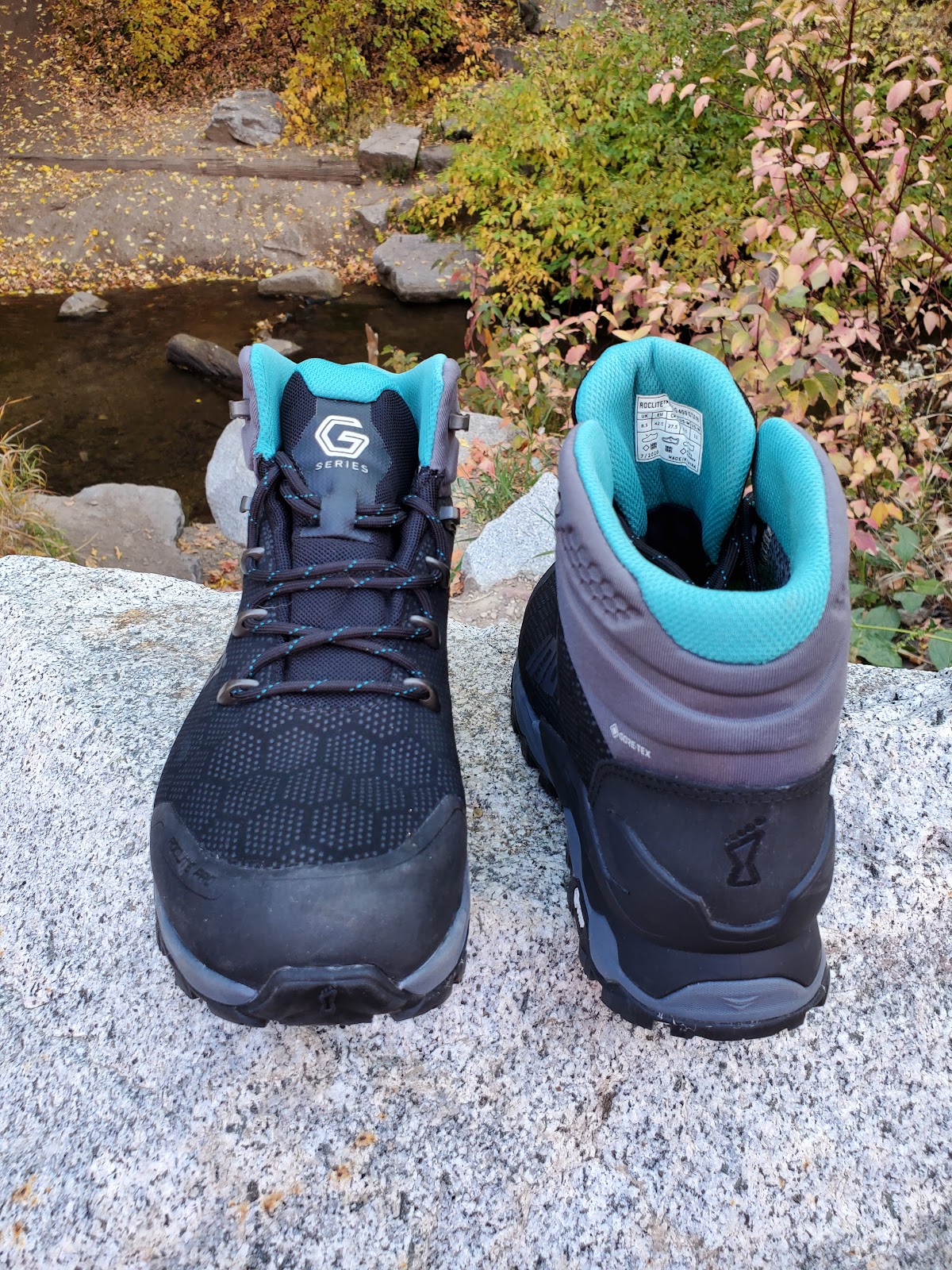
There is a roomy toe box, without a floppy feel.

The collar is pretty stout, but comfortable on skin. The ankle feels stable and is well secured.
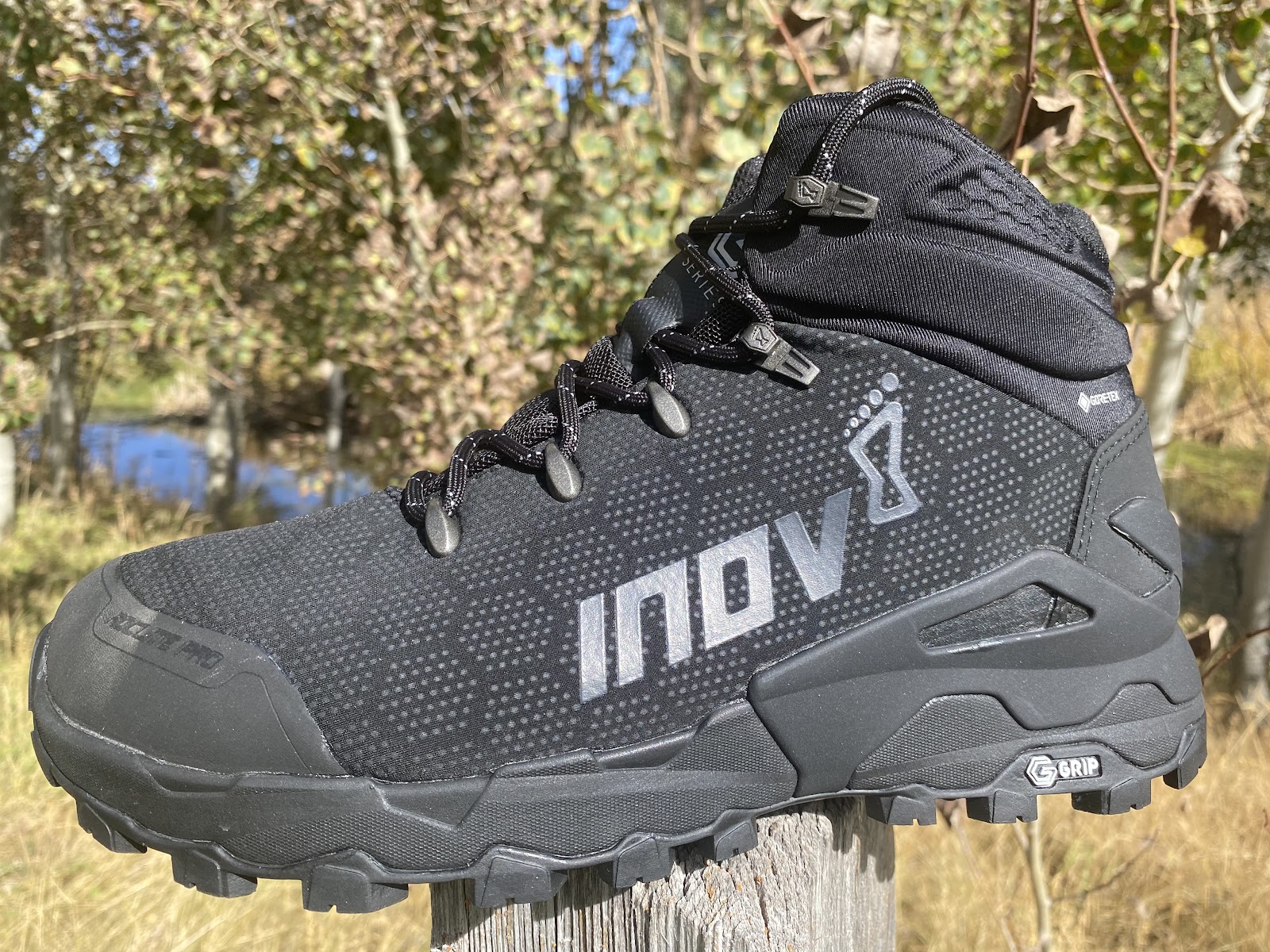
Sam: Schoeller, a Swiss company well known for highly protective and engineered fabric and coating technologies of all sorts provides a ceramic coated fabric for additional mesh durability.

This is important as while we have a very stout toe bumper the rest of the upper is support overlays and lower rand protective overlays free but for where the side Meta-Plate Pro plastic rises as the External Heel Cage. The upper is designed to flex with the foot but without overlays and protection one might worry about abrasion durability and thus the Schoeller ceramic coated fabric.
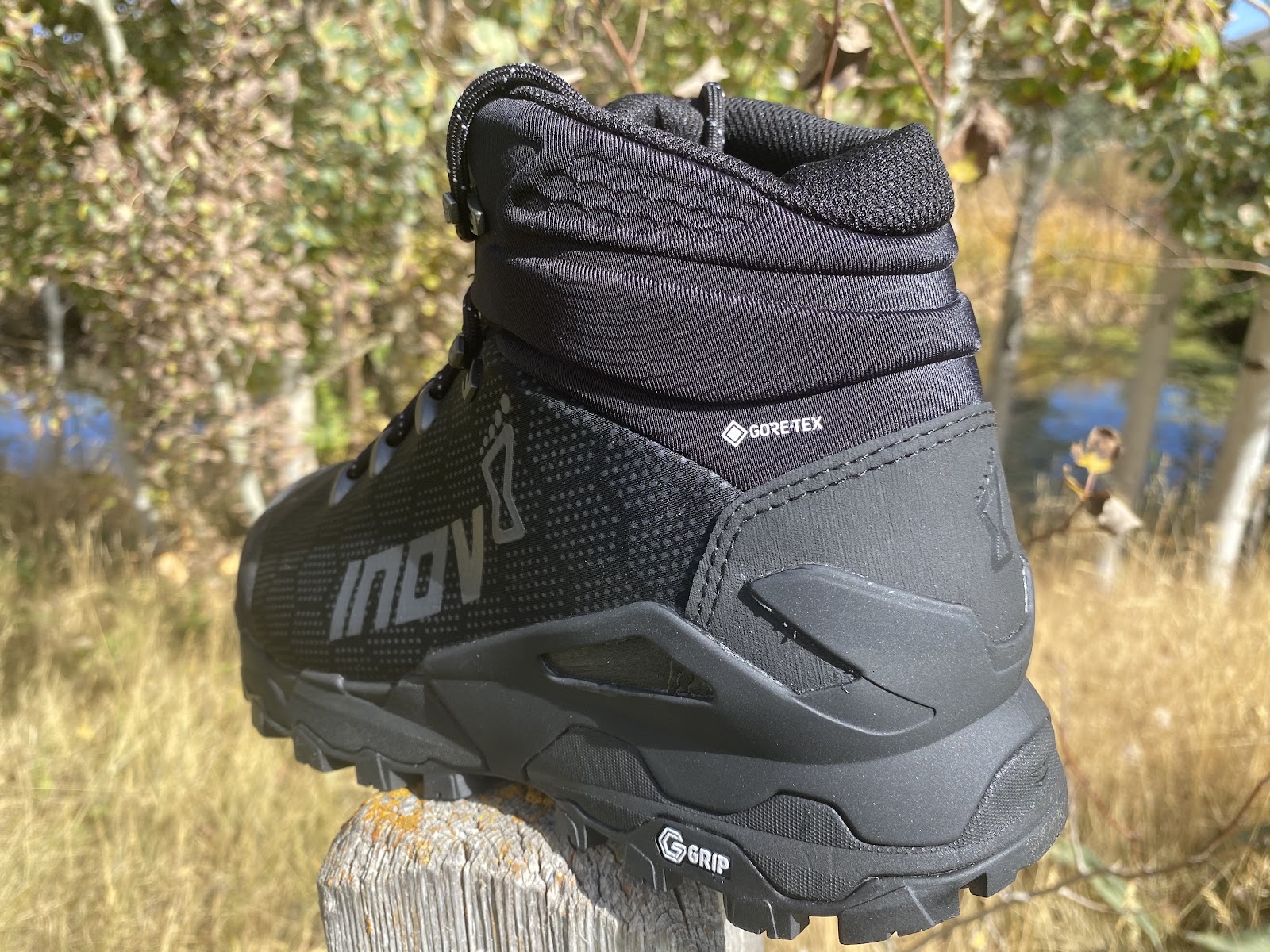
The rear molded collar is more than adequately supportive and superior in support to other mid height light boots I have tested such as the Hoka Toa and Topo Trailventure WP,, but as with all such collars, not totally mountain boot secure, a tradeoff for the agility here.
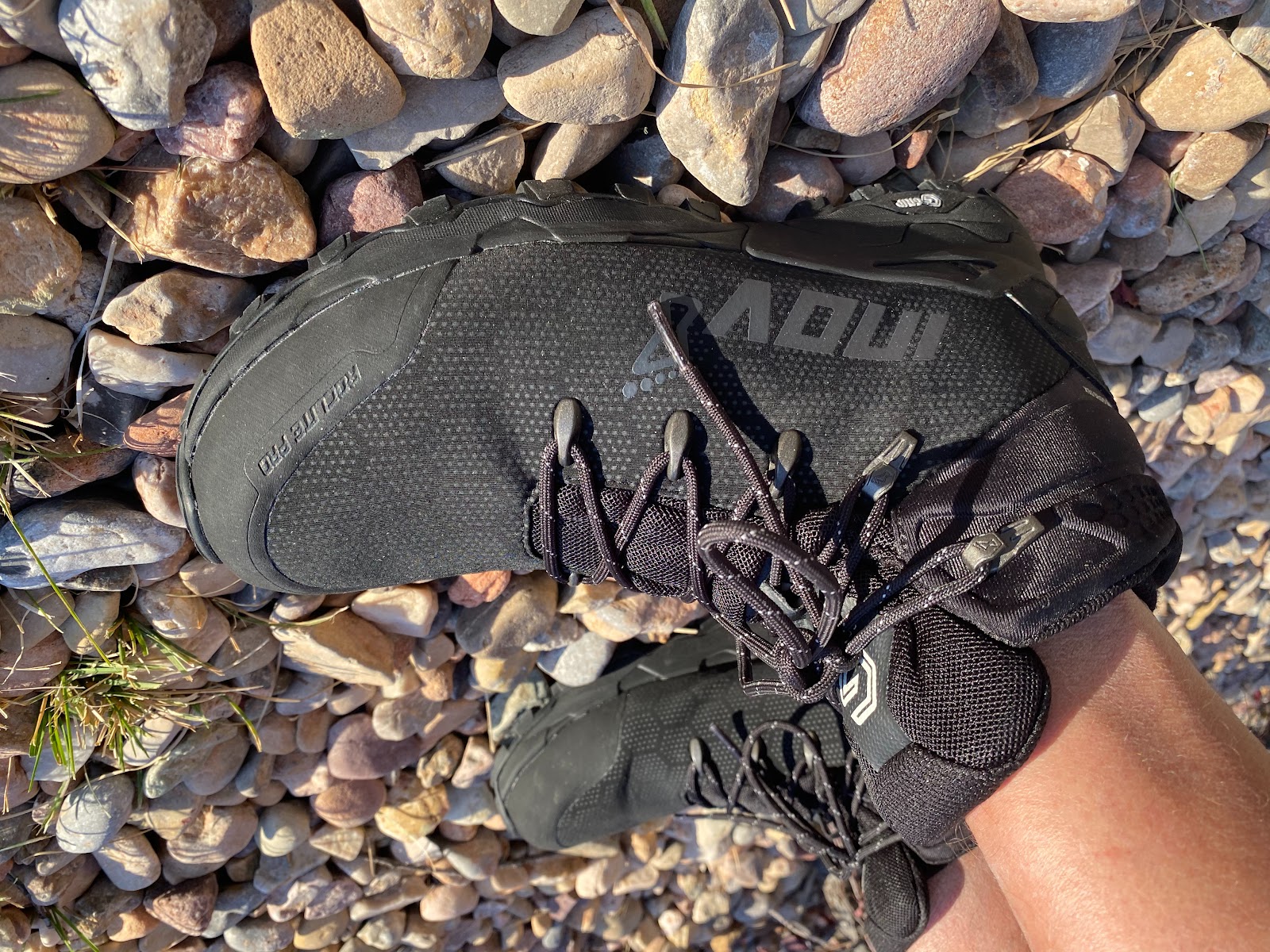
The hold overall is not quite up to the level of the radical Hoka TenNine Hike a somewhat heavier boot with a very broad platform, somewhat stiffer collars, and narrower forefoot with lacing extending further forward but which is clearly not as “runnable” boot as the G 400.
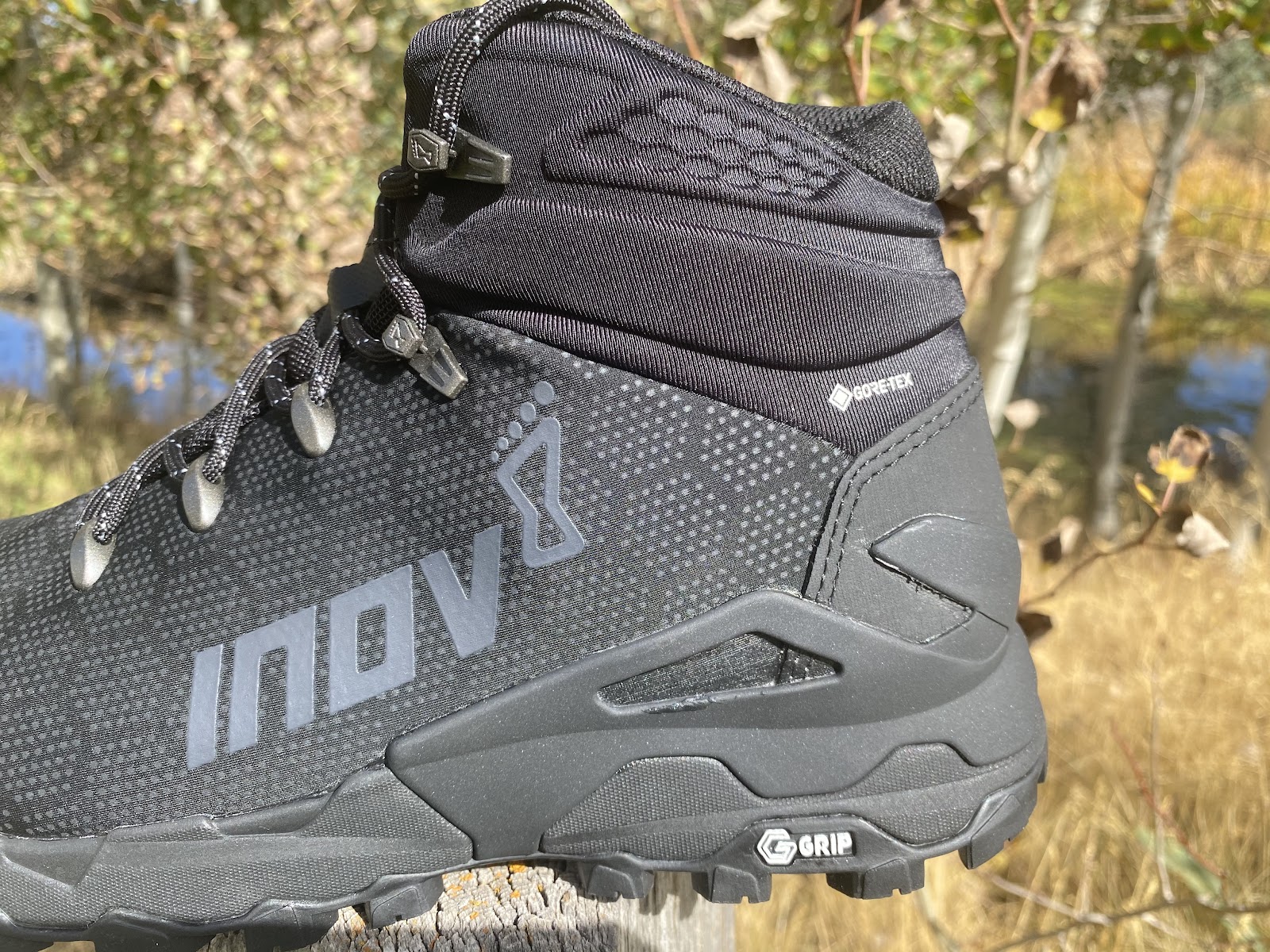
The top two lace hooks have grooves to lock the laces. Effective but I did find I needed to relace on occasion but less than the Toa and Topo and more frequently for sure than the TenNine. I do think the collars could benefit from a touch more stiffness

The Gore-Tex bootie is Gore’s XCR or Extended Comfort Range and on a warm day proved plenty breathable. This said this is not an ideal desert boot although in wet and snow you will not regret the protection and warmth the membrane will provide.
Midsole

Sam: The midsole is fairly conventional in feel without the energetic bounce of the Terraultra G 270, a far lighter trail runner for example. There is plenty of cushion of a denser sort somewhere between a classic trail runner and a hiking boot. For sure this is not a Hoka bottomless cushion feel as there is a 20mm heel, 12 mm forefoot midsole stack, so relatively thin overall but there is more than adequate cushion with plenty of trail feel to go with the fast and agile purpose of the boot.

As said above, the External Heel Cage which extends further forward the whole being called the Meta-Plate Pro gives the boot lots of underfoot torsional rigidity and rear stability and rock protection while also giving it front flexibility something I really like in a boot or shoe designed to climb fast.
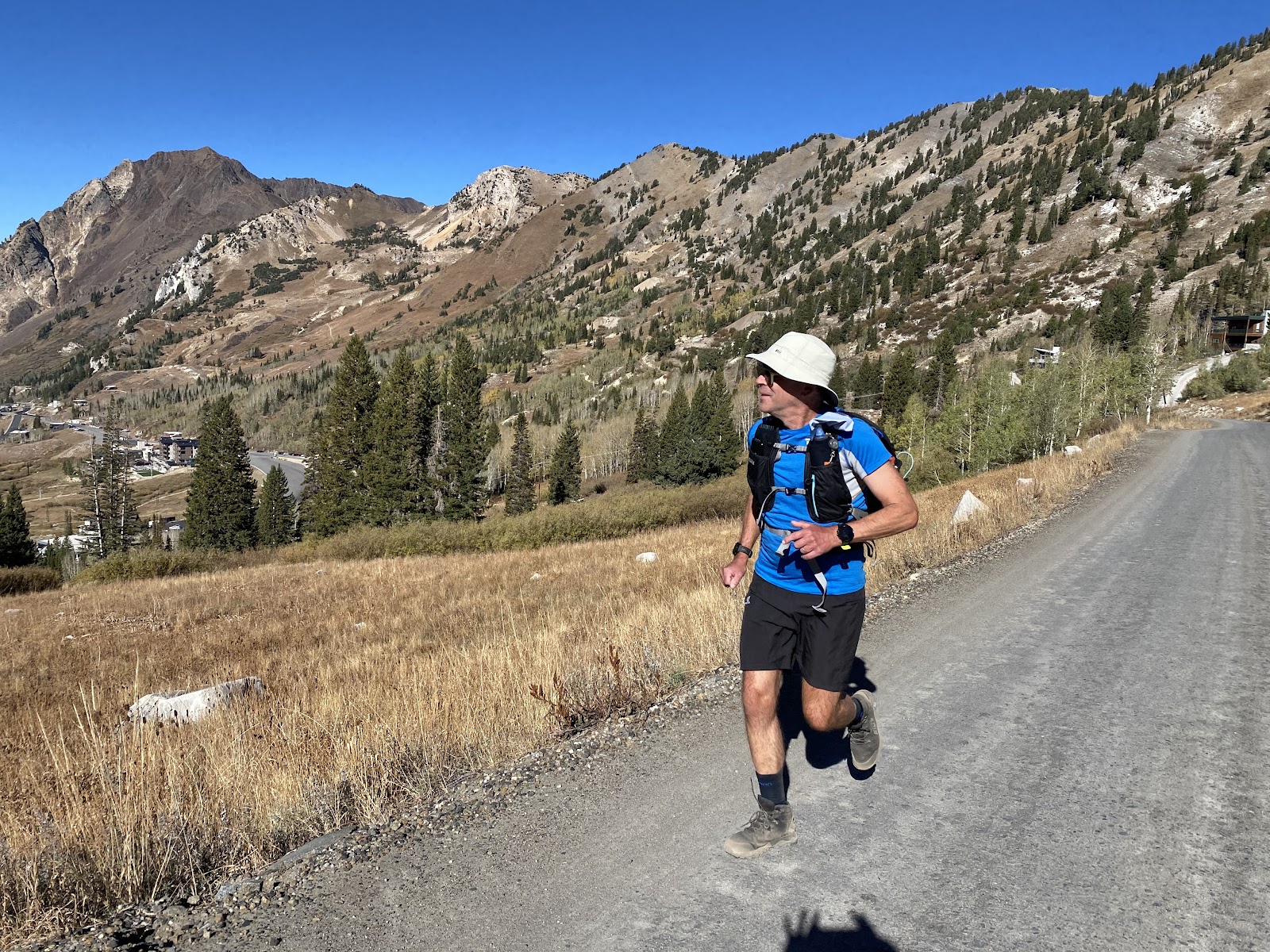
Unlike a traditional boot the platform is clearly runnable as I even took them for a short dirt road run above Alta, Utah during a hike. Mount Superior is to the left at the top of the picture.
Jana:

EVA midsole provides good stability and cushions the foot well with each step with a lightweight and flexible feel.
Outsole
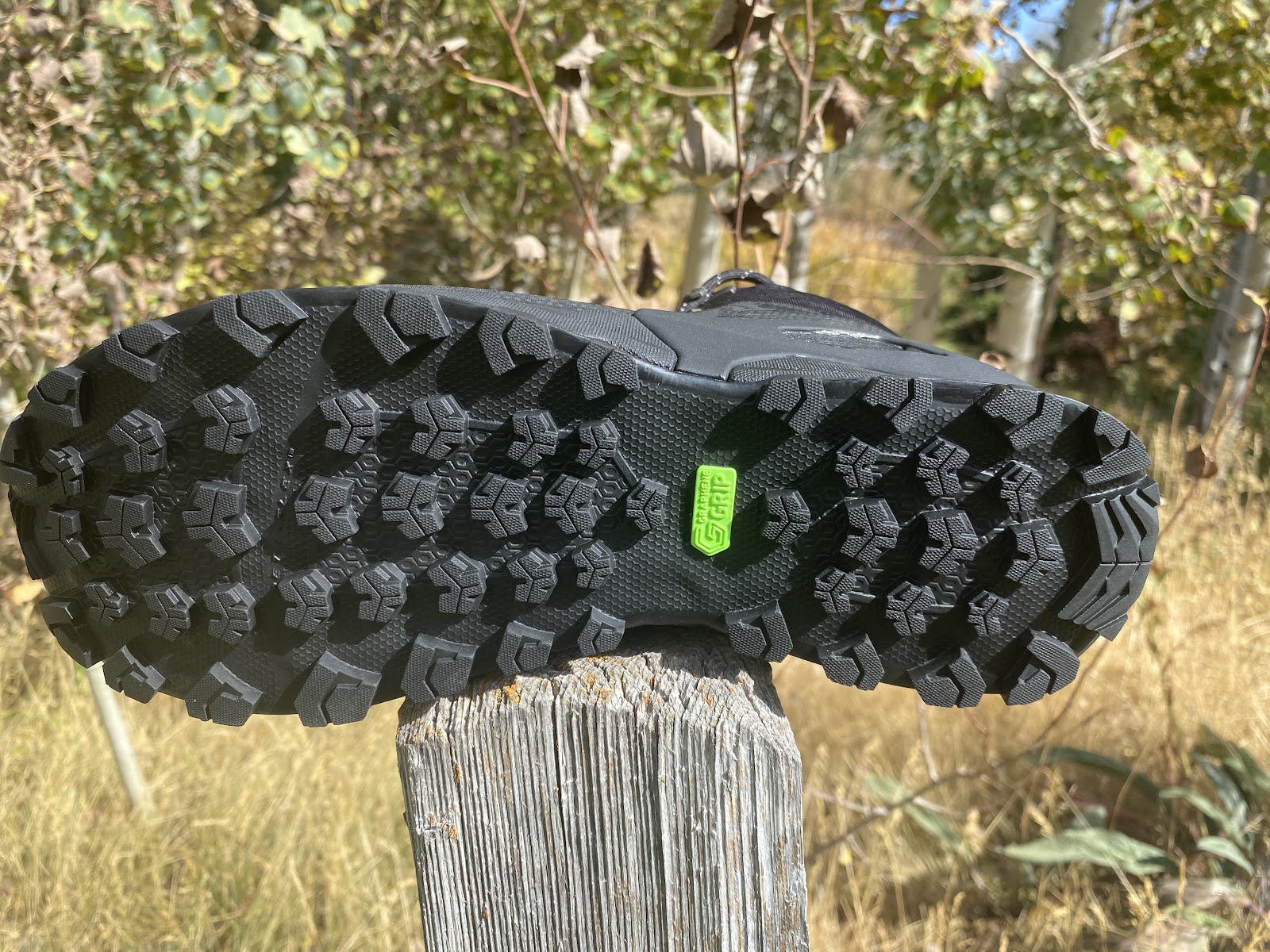
Sam:
The G 400 box below makes big claims and while I have not taken them on mud or snow, on dry ground and wet and dry rock the Graphene Grip is outstanding while its elastic properties add a bit to cushion and trail feel. As with the G270 this outsole compound is a step above in its grip and durability.

Jana:

The Graphene Grip outsole feels stable on any terrain. The 6mm lugs are very grippy on steep and rocky terrain (even during steep descents), and a flexible front makes for a smooth uphill ride. And the rockplate makes for a very comfy ride over a rocky terrain. The only slight problem I experienced is the mud build up between lugs, as they might be positioned too close to each other to prevent mud from shedding rapidly
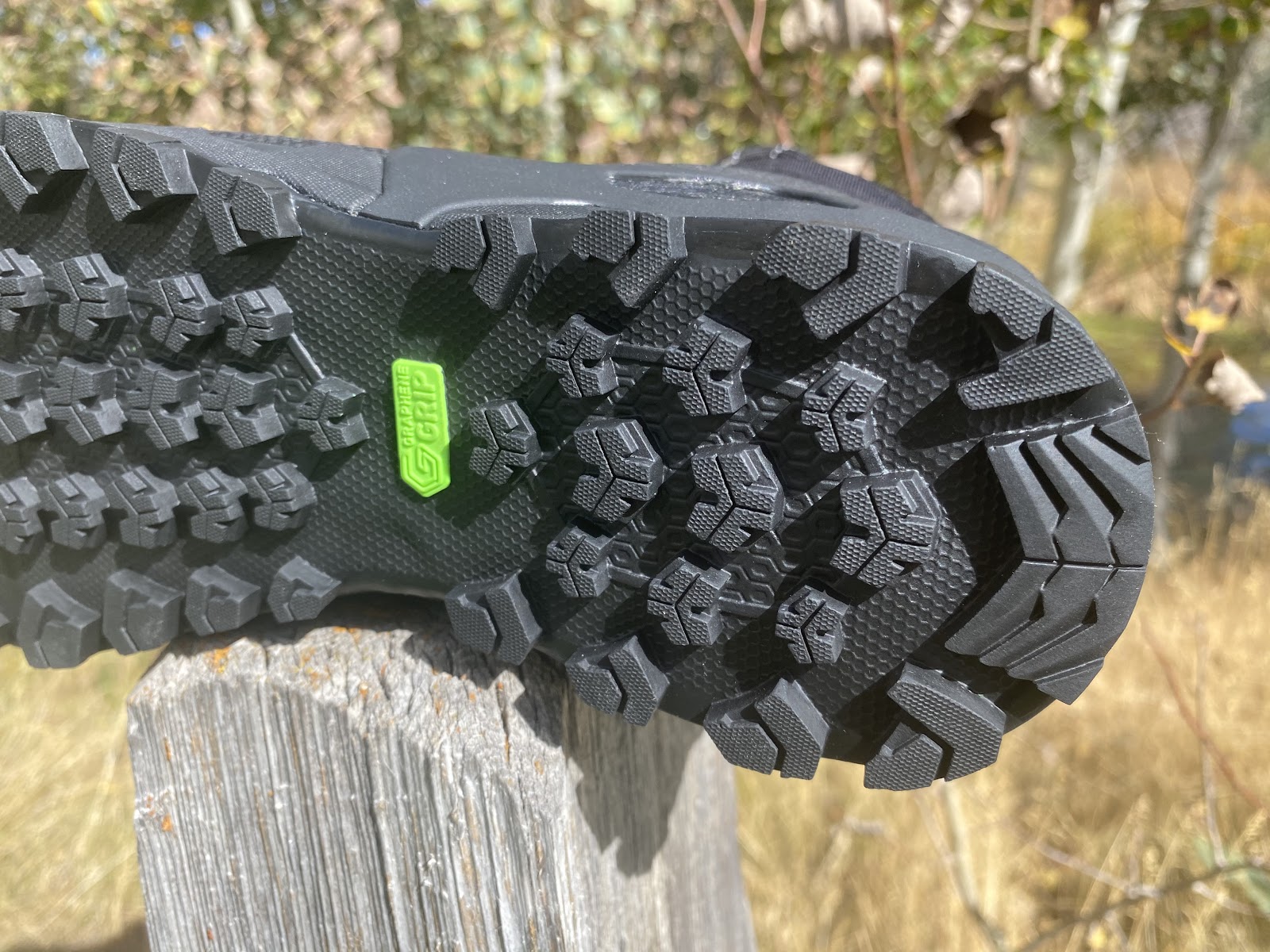
Conclusions

Jana:
As I mentioned before, I was a bit skeptical about using “actual” hiking shoes for hiking. With a unpleasant previous experience, I have been using trail running shoes as a substitute. I did about 70 miles of fast hiking on rugged mountain terrain in them. Needless to say I am very pleased with the overall feel, stability, and responsiveness of this shoe.

I don't have any other hiking shoe/brand to compare it to by experience, and that may be a bit one sided view. However, as a "freshman" to hiking shoes, the Roclite G400 moves along nicely on all kinds of terrain, has plenty of cushion and feels secure and stable. The outsole equipped with 6mm lugs is very responsive to any terrain. The front flexes well, and the roomy toe box feels comfy.
The only slight problem I experienced is the mud build up between lugs, as they might be positioned too close to each other to prevent mud from shedding rapidly
I have not used them for a multi-day hiking adventure yet, but the all day wear experience was rather on a less breathable side then I would expect. However, the fully waterproof Gore-Tex upper is a good trade-off to keeping feet dry for days when it is needed.
Jana's score: 8.6/10
Ride 9, Fit 9, Value 7, Style 8.5, Traction 9, Rock Protection 9
Sam: The G 400 is a technologically advanced ,light and fast hiker with what should prove a surprisingly easy on the foot and roomy (too roomy as it is also overlay free upfront? ) highly durable ceramic coated upper with Gore-Tex XCR weather protection,, a sophisticated stability and rock protective plastic chassis from heel to toe and of course the incredible Graphene Grip outsole.
Sitting just above a heavy duty trail runner in weight with an underfoot feel and flexibility it is closer to a classic trail runner than a boot or max cushion trail shoe with an upper closer to a boot than a trail runner. As such it delivers a ride made for going fast uphill and downhill and can even be run.
I wish for a bit more cushion stack and the energetic bouncy feel of the G 270 midsole, no slouch on any terrain hiking or running and far lighter, almost 5 ounces lighter and my trail runner of the year before even getting into its prowess hiking the super rough White Mountains of New Hampshire.
At $235 I would also wish for lighter weight, with the tech included of course! Many hike in trail running shoes and while likely durability will be superior here, and that is a big factor, as a boot at this pricing, it should be light enough to be yet more “runnable” and a bit more secure in its upper for fast movement on rough terrain including with a pack. A few strategic overlays, without compromising the admirable front flexibility and rear under foot stability and a bit more rear upper collar stiffness would in my view perfect the G400. Mind you it is excellent in those respects but the bar is set high by the G 270 and the pricing. All of this said, I can’t think of a better boot for deep snow running, snowshoeing and fast moving without a big pack on rough terrain.
Sam’s Score: 9.0 /10
Ride: 9 (30%) Fit: 8.8 (30%) Value: 8 (10%) Style: 9(5%) Traction: 10 (15%) Rock Protection: 9.5(10%)
Comparisons
Jana: As mentioned, I am mainly a trail runner, trail running shoes have been my go to shoes for everything off road related. So comparing trail shoes to hiking boots may not be the best scenario, but for someone who is trying to decide between such options, I hope I can help.
Salomon Wildcross (RTR Review)
Jana: From trail running shoes I have used recently, the most similar to Roclite G400 would be the Salomon Wildcross. They both have similar shape with a wider toe box, outstanding grip on any terrain, and comfortable feel.
In my opinion where they differ is the durability. While Salomon is known for making fine and durable shoes, I am not sure if they will last as long as Inov-8's Roclite G400. Simply because I tried to rip the upper of Roclite G400 on purpose (on sharp rocks outdoors), without success. The smooth and pretty much seamless upper does not give much for an option to do so.
As for handling the wet, Roclite G400 is waterproof, whilst Salomon Wildcross is not, at least in the version I tested although a GTX version is available.
Wildcross dries fast and stays light when wet, you won't need to worry about that wearing Roclite G400.
Hoka One One Toa (RTR Review)
Sam: At about 14.3 oz in weight at a US men’s 9 so about the same weight as the G 400, the Toa has more and softer cushion, a considerably less supportive rear collar and less overall stability and a fine but not as aggressive outsole. Its water proof breathable eVent upper ( in the 2020 version Gore-Tex lasted over 400 miles including 200 miles of mellow terrain across Switzerland and then about 200 miles of New Hampshire boulders for my wife’s pair after showing early wear.
The significant difference in price $170 for Toa vs $235 is of note and especially for more mellow terrain the Toa is a better value.
Hoka One One TenNine Hike GTX (RTR Review)
Sam: An important match up. The super broad platform TenNine with its distinctive swallow tail and propulsive rocker is considerably more cushioned and more stable and has a more supportive upper for sure. It is not very agile on steep uphills or fast downhills, has no ground feel to speak of but otherwise rolls along like no other boot with superb leg saving protection. It is not a boot for fast as G 400 is but worthy of consideration for long long hikes on all terrain but the more technical where the agility of the G 400 will really shine
Hoka One One Kaha (RTR Review)
Sam: The high top Kaha has more cushion stack on a wider platform, a soft pliable upper and not as stout collar support and is more focused on trekking than hard core fast hiking as the G 400 is. At 18.2 oz it weight almost 4 oz more than the G 400 and at $15 less is about the same price. For long long hikes on mellow terrain it might be a better choice but for hard core fast hiking and some scrambling nod to the G 400.
Topo Trailventure WP (RTR Review)
Sam: Similar in underfoot cushion and protection with very decent but not the superb traction of the G400 the $145 Topo is almost $100 less but has far less rear upper support and a super broad toe box that while a great choice for wide wide feet does not have the hold of the G400 for narrower to medium feet.
Read reviewers' full run bios here. The product reviewed was provided at no charge for testing. The opinions herein are the authors'.
Comments and Questions Welcome Below!
Please let us know mileage, paces, race distances, and current preferred shoes






